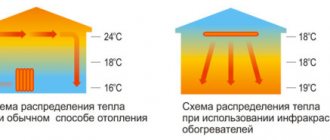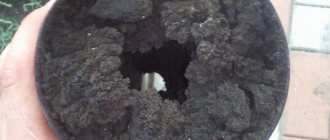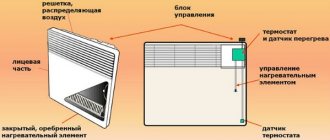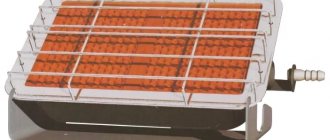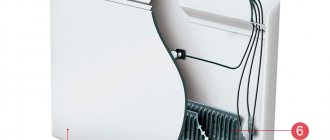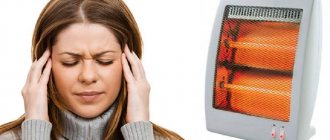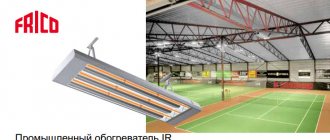Russia is a country with different climatic zones, which is no stranger to severe frosts and long winters. And it’s no wonder that sometimes, in addition to centralized heating, additional heating equipment is used, and in particular, heaters. Among the latter, there are even Soviet models that continue to function, the safety of operation in modern conditions of which will be discussed.
Principle of operation
An oil heater consists of a metal body that visually resembles a stationary battery, special mineral oil and a heating element.
After turning on the device, the heating element begins to work, heating the oil to the desired temperature. Next, the oil transfers its heat to the metal shell, which gradually heats the surrounding air.
All modern models have several operating modes, thanks to which you can choose the intensity of heating the air in the room.
The built-in timer helps regulate the temperature: when the air is heated at a given temperature, the device turns off, and when it gets cold, it turns on.
Convector type devices
They appeared relatively recently, but have already managed to occupy their niche. A convector differs from an oil heater both in its operating principle and in appearance. It is a flat panel that is usually attached to the wall. The body of the device has a rectangular shape, characterized by considerable length and height and very small thickness.
The operation of the device is based on convention . Cold air, which is heavier, enters through holes located at the bottom of the housing and hits the heating element. After this, the air temperature increases, it becomes lighter, rises and exits through the slots on the top of the heater. Some convector models are equipped with a system of controlled blinds that give the air flow the desired direction.
Like an oil cooler, the convector has a thermostat . With its help, you can regulate the temperature in the room and stop heating when it reaches the desired value. The thermostat sensors of a convector heater are located much better than those of an oil heater. Thanks to this, the air warms up more evenly.
Types and characteristics of oil heaters
All radiators operate according to the same algorithm, but differ in the set of additional functions, type of mounting and price. Depending on the goals set for the device and its location, oil radiators are divided into:
- Wall-mounted – economical in terms of electricity consumption.
- Floor-standing ones are popular because of their mobility.
- Tabletop - low level of heat transfer.
- For cots.
- Ceiling.
Some models are equipped with a fan that disperses flows of warm heated air throughout the room. The disadvantage of such a device is noise during operation. The developers of some companies have included a humidifier in their models.
This device is especially relevant in the cold season, when the air outside becomes much drier, and the heater itself gradually dries it out further. Some units have a delayed start function.
Before using the device, read the instructions
As for more detailed information on using the device, you should look for it in the instructions for the specific model. Each manufacturer sets its own requirements (in accordance with the characteristics of the equipment, its type) for the operation of the convector. Compliance with them allows you to increase the operating time of the heater, as well as avoid the need for regular repairs.
Each heater presented in KSK TRADE is accompanied by a detailed user manual, which will simplify your operation of the device and make it as convenient, safe, and long-lasting as possible.
Advantages of oil heaters
- High level of device security. In an oil radiator, all heating elements are hidden inside, and the outer shell heats up to a temperature of no more than 60 degrees.
This eliminates the possibility of a fire due to a fall or burns to the skin surface due to tactile contact. The last factor is important in families with small children.
- Long service life. The device is designed in such a way that the components do not burn out due to long continuous operation. The device can work without turning off for up to three days.
- The compact size of the device and its mobility allow you to move it to different parts of the house or apartment. And quiet operation will not cause any discomfort.
- The price of oil radiators is affordable. The cost depends on the number of sections that the device has.
- No foreign odors are emitted during operation of the device. Radiators do not dry out the air in the room, which means that you do not have to spend extra money on purchasing a humidifier.
- To install such a heater, you do not need special knowledge or tools. You simply plug in the device and enjoy the warmth.
A little about safety
An electric heater, like any complex device, can cause a fire. To eliminate such risks, basic safety rules must be followed.
Among them:
- Regularly check sockets, wiring and plugs/breakers, since the heater puts a strain on the electrical network.
- Keep pets, who like to chew cables, away from the device.
- Monitoring the integrity and serviceability of the device. If the device sparks and smells of burnt plastic, immediately turn it off and contact a store or service center. The same thing applies if drops of oil appear on the floor (relevant for an oil heater).
- It is mandatory to disconnect the heater from the mains if you leave home.
- Do not cover the heater or dry things on it - they may catch fire.
- Do not install the heater close to a wall, and do not use it in a room where there is debris or flammable objects, liquids, etc.
- The heater should be installed only on the floor (if this does not contradict the operating instructions), away from curtains, furniture and walls. The minimum recommended distance should be at least 0.5 m.
In general, the operation of Soviet heaters is quite possible, with the caveat of full compliance with safety regulations. On the other hand, it is better to acquire modern devices, getting much greater efficiency without unnecessary hassle.
Disadvantages of oil heaters
An oil cooler has several negative aspects that you need to be aware of before purchasing. They are quite controversial and can be easily eliminated:
- Heavy radiator weight. It will not cause any difficulties when moving, since each model is equipped with wheels, and there is no need to lift the unit at all.
- Long room heating time. First, the heating element inside the device heats the oil, and only after that does it heat the outer shell of the radiator.
But this drawback can be easily eliminated if you initially purchase a radiator with a built-in fan, which will disperse warm air around the room, thus heating it up faster.
How to choose an oil heater
Consider simple rules:
- Heater power. To heat 10 square meters of area you need about 1 kW of power. The manufacturer does not produce radiators with a power exceeding 3 kW. To heat larger rooms, you will need several copies.
- Size. The number of sections ranges from 5 to 14. The more sections in the radiator, the faster it will heat the room and the more electricity it will consume.
- Model design . When purchasing, pay attention to the presence of a light indicator, temperature controller and several operating modes. There should also be protection against overheating of the device, which will protect you from unforeseen situations.
With several modes, you can independently regulate the temperature that the device produces, and thus save the energy it consumes.
- Timer , with which you program the radiator to turn on or off for a certain time.
- Built-in air humidifier . During the cold season, the air becomes dry, which negatively affects the skin. The built-in air humidifier operates while the heater itself is operating, bringing the humidity in the room back to normal.
- Built-in fan. It will speed up the process of heating the room, but models with this function are much more expensive.
Also pay attention to the following aspects:
- Give preference to radiators with narrow sections. They heat up faster and transfer heat to the room. When reducing the size of sections, increase their number.
- Large sections take a long time to heat up and cool down, this provides additional heat, but requires additional electricity costs.
- If the device is lightweight, but at the same time large in size, it means that the manufacturer has saved on materials.
- Radiators of dark color give off heat better.
Oil type heaters
This type of heating device is perhaps the most common in everyday life. Their popularity is facilitated by their ease of installation and use, which does not require any special knowledge or skills. You just need to place the device closer to the desired location and plug it into the network. The electrical circuitry of such devices is simple, so the likelihood of device failure is low.
By its design, the oil radiator is a hermetically sealed metal case with a heating element installed in it, and all free space inside is filled with mineral oil. This oil ensures efficient heat transfer from the heating element to the metal body. For greater heat transfer, the radiator housing has a multi-section design. The greater the number of sections in the heater, the faster the room will heat up.
Temperature regulation is ensured by the presence of a rheostat. Oil radiators also have a compartment for the power cable and an overheating protection device. Some models of oil radiators have a sensor that responds to the deviation of the device from the horizontal. This increases the safety of the device, since it automatically switches off if it tips over. To make it easy to move these heaters around the apartment, they are equipped with handles and swivel wheels.
The advantages of oil radiators include:
- affordable price;
- quiet operation;
- ease of moving the device between rooms.
Depending on the area and volume of the room heated by the device, it is important to choose an oil radiator. For example, for a room of 10 square meters. meters and a ceiling height of less than 3 m, a 1 kW heater will be sufficient. Most oil radiators sold have a power of 1 to 2.5 kW.
The thermostat is responsible for maintaining the constant set temperature in the oil heater, which automatically maintains it at the required level. Models that have a timer look attractive. If it is present, the heater will turn on at the right time, and after some time it will turn off. Thanks to this, it is convenient to schedule the device to turn on in the morning or evening, and during the day, when everyone in the household goes to work or school, the device will turn off. Accordingly, the timer will provide significant energy savings, which will have a positive impact on the family budget. As for the oil heater control system, it can be either conventionally mechanical or more modern electronic.
It is best to use oil radiators for heating small rooms, since it is in this case that the room temperature will reach comfortable values earlier. In general, an oil radiator is an ideal device for local heating, partly due to its mobility.
Which is better
Before purchasing a radiator, you should calculate how much area it will need to heat. The heating function depends on the power of the radiator and the number of sections.
The power is selected depending on the size of the room in which the radiator will operate: for 10 square meters of room you need 1 kW of generated electricity.
The formula applies to rooms where the ceiling height is no more than 2.75 m. If the ceilings are located higher, the required power can be calculated using the following algorithm:
- Multiply the length of the room by the width to get the area.
- Multiply the resulting number by the height of the room, this way you will get the required volume.
- Divide the resulting figure by 25, because 1 kW of energy per 25 m3 is calculated. The result obtained is the power needed to heat the room.
Then it’s a matter of individual taste and financial capabilities. A simple oil heater has a standard set of functions and is inexpensive.
Models equipped with fans, timers, humidifiers and remote controls are more expensive, but more comfortable to use.
How long will the convector last?
If we compare classic radiators and convectors, the latter will clearly outperform the former in terms of operating time.
The average period of correct operation of such heating devices is 20-25 years. Moreover, the duration of their operation largely depends on the internal components. The better the quality of these elements, the longer the device will be able to operate normally. KSK TRADE presents in-floor built-in convectors with components made from high-quality materials. The minimum service life of heaters is 20 years. Therefore, we confidently provide a guarantee for the equipment and are completely confident in its quality.
Exploitation
Precautionary measures:
- Before you start using the device, make sure that the voltage in the apartment outlet corresponds to that recommended by the manufacturers.
- If you are not using the device, unplug it from the outlet.
- Do not leave the device on when there is no one in the room.
- Do not cover the device with clothing, this will cause overheating or a fire. It is better to place it at a safe distance from flammable substances.
- Keep the device clean.
- In the event of a breakdown, do not try to disassemble the radiator parts yourself; it is better to leave this work to professionals.
- Supervise children closely if they are in the same room as the device is in use. Do not allow them to play with the cord or appliance, as this may result in short circuit, electric shock or fire.
- Carefully monitor the condition of the device itself, the wire and the plug. Do not use the heater if the cord or plug is damaged.
- The device is intended exclusively for indoor home use.
Preparing for work
If the device was purchased in the cold season, then it must be carefully unpacked, placed on wheels and left for at least 3 hours.
After this, plug the radiator into a grounded outlet and leave it to work for 1 hour in a ventilated area. This will evaporate all foreign odors that may appear at the initial stage.
Oil Cooler Maintenance
Oil heaters do not require special maintenance during their service life, unless there are any complaints or complaints.
- If you need to store the device for a long time, wipe it with a slightly damp cloth to remove dust and dirt, disconnect the cord, and roll it up carefully. Remove the support wheels and put them in a box, which you close tightly.
- When you need the heater again, take it out of the box, wipe it off again from dust, and reassemble it. Carefully inspect the device for any deformation or oil leakage.
Oil cooler disposal
When the oil heater becomes unusable, it must be disposed of according to the following scheme:
- Cut off the power cord from the unit.
- Drain the oil, which is dangerous for humans, and hand it over to a special collection point.
- The body can be sold for scrap.
Guarantee
The warranty period for storage of oil radiators is 1 year, and for use - 2 years.
During the warranty period, the manufacturer guarantees satisfaction of the buyer's requirements related to problems in the operation of the radiator, subject to the rules of operation, transportation and storage of the device.
Malfunctions
The most common problems with oil radiators are:
- A cracking noise is heard when turned on and during the first 10-15 minutes of operation. If after this time the cracking disappears, it’s okay. It occurs when the oil inside the radiator heats up.
Perhaps drops of water got into it, which causes such a reaction. This is possible if the device was assembled in conditions of high humidity.
- The radiator does not turn on. First, carefully inspect the cord and plug for cracks or creases. If they are not found, try plugging the heater into a different outlet.
If this does not work, then the problem is in the contact, which has come loose. Try to repair the device yourself or send it to a service center, where experienced technicians will solve the problem.
- The device turns on, but does not heat up. At the same time, indicator lights, a fan and other additional devices on the case work.
The cause of such a breakdown is problems with the thermal relay; it cannot be eliminated without special tools. Contact the service center.
- Oil is leaking. Such a breakdown occurs due to a manufacturing defect (poorly sealed seam) or a long period of use of the device.
Over time, the metal at the joints burns out and becomes thinner, which leads to this type of failure. Unfortunately, it is impossible to repair an oil leak either independently or at a service center.
If the breakdown is serious, you should carefully consider the prospect of buying a new radiator, because sometimes repairs cost more than a new device.
Operating principle of an electric convector
The algorithm of action is already clear from the name of the technique. The basis of operation is convection. Heat transfer is based on mixing cool air with hot air. As a result, the room is neither cool nor hot.
Due to the convector circuit, the device has a special design: narrowed at the bottom and widened at the top. This way air can easily pass through it. There is a heating element below. The body of the heater is empty, which allows air masses to remain inside. The switched off device is the same t as in the room.
What happens when the convector is turned on:
- The heating element reaches operating temperature, heating the air in the housing.
- The heated flow tends upward through the air distribution louvers.
- New air portions are “sucked in” through the air intake at the bottom of the unit.
Such devices use two types of heaters: a standard heating element (metal tube with aluminum fins) or a monolithic heating element. The latter has better heat transfer, i.e. the heating process occurs faster.
Interesting article: How to choose an electric convector for your home and garden
Manufacturers of oil heaters
Ballu
The company is known for high-quality products with a matte textured coating, which increases heat transfer by 20%. The products are coated with an anti-corrosion compound, which prevents the device from rusting.
The new generation thermostat closely monitors the room temperature. Among the distinctive features, it is necessary to highlight the special design of the legs, which make it impossible for the heater to fall.
De'Longhi
The advantages are absolute noiselessness when the heaters operate, uniform heating of the rooms and the absence of open heating elements that can cause burns.
The combination of efficiency, functionality and quality makes the heaters of this company in demand.
Oasis
The main direction is the production of high-quality heating equipment, among which a special place is occupied by oil radiators of various types: cast aluminum, steel, panel and bimetallic radiators.
Recahta
A Russian brand that has won a large number of fans in a short time.
The company is constantly moving forward, making oil radiators more and more advanced and of higher quality, providing them with a large number of additional features.
Scarlett
The company does not specialize exclusively in heaters, but has a wide selection of products for the home.
Sinbo
The company has been in the heating equipment market for more than 30 years, but does not have a huge number of oil radiator models.
Among 5 models that differ in appearance, power and number of sections, everyone can choose the option that suits them perfectly.
Supra
The company constantly pleases its customers with an updated range of oil radiators. The models of the new line have heaters with a large list of additional functions.
Heater Safety
Both options use a thermostat. Masleniki are equipped with a mechanical thermostat. Convectors can also use an electronic version.
The thermostat allows you to automatically maintain and not exceed a specified temperature threshold. The protective limiter prevents overheating of the housing, avoiding failure of the device and the occurrence of a fire hazard.
To ensure the safe use of heaters, manufacturers take other measures, such as:
- installation of heating elements inside the housing - direct contact with them is excluded;
- trip shutdown - if the heater falls, it turns off automatically (available in BEC/HME-1500);
- parental control - blocking control buttons when using the heater in the nursery or other rooms.
The walls of the convector housing are thermally insulating, which eliminates the risk of wallpaper or carpet on the floor catching fire when in contact with the device. The outer surface is warm when heated.
The surface of the oil pan is quite hot during operation. Therefore, it should be installed in a place where there are no flammable objects nearby, and the access of children and animals, who may unknowingly touch the heated body, is limited.
When choosing an oil heater or convector, we pay attention to the protection class of the equipment. Typically this is IP 20 (like the CH-1500MOW) or IP 24. In the first case, protection is provided against contact with the internal elements of the device, i.e. a person will not be able to accidentally touch live parts inside. The second also provides protection from moisture and equipment breakdown due to splashes on the device.
